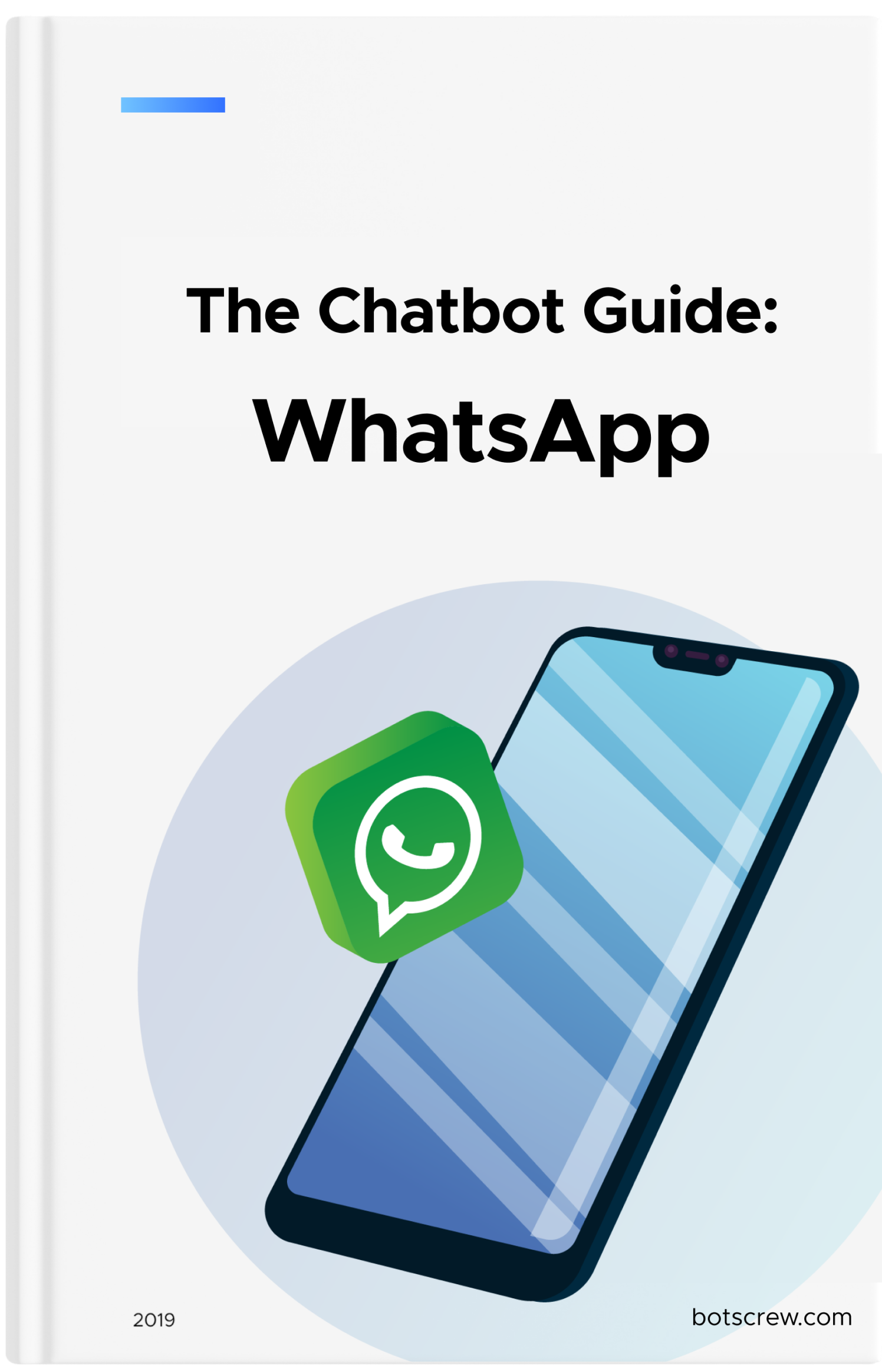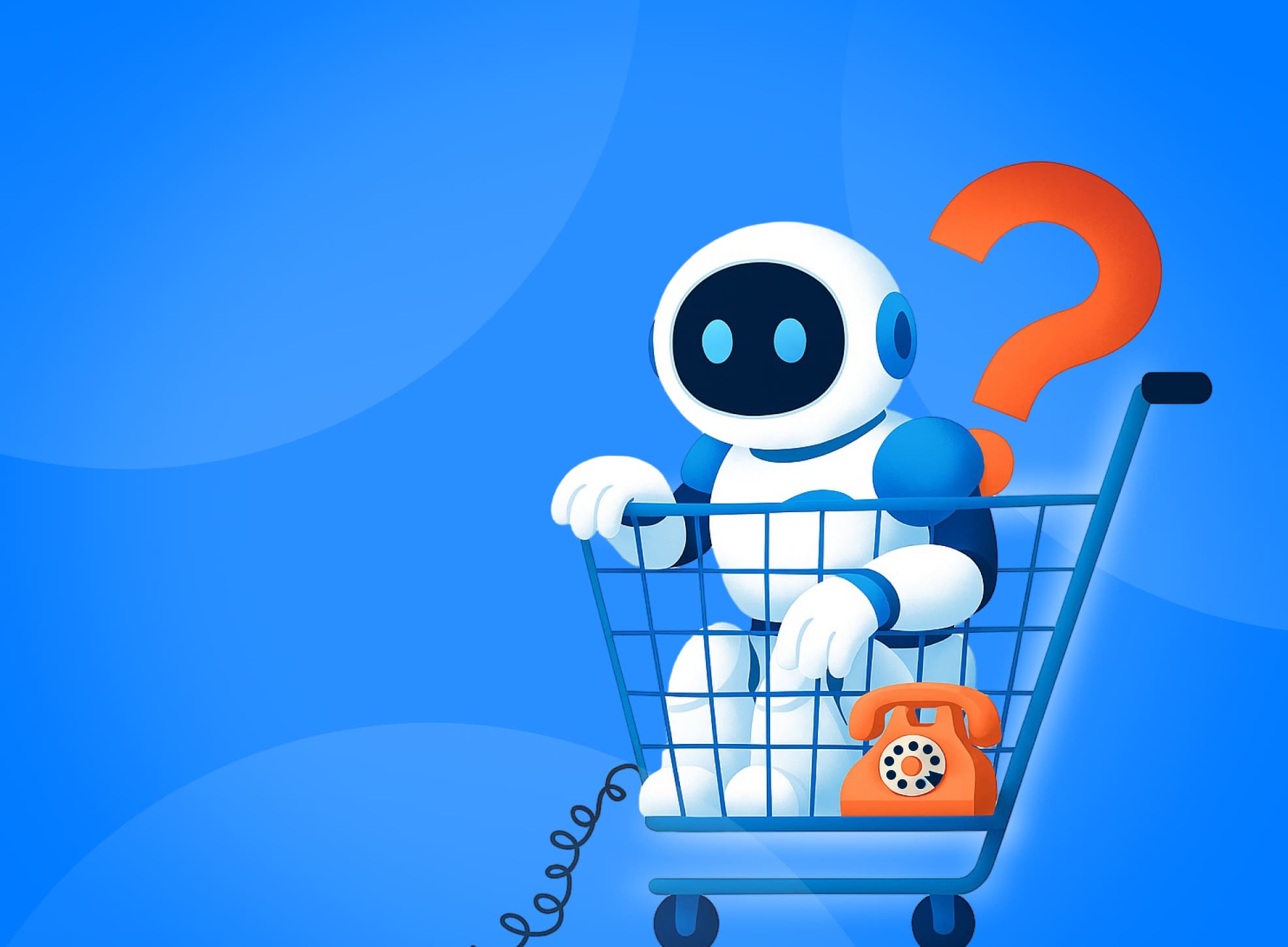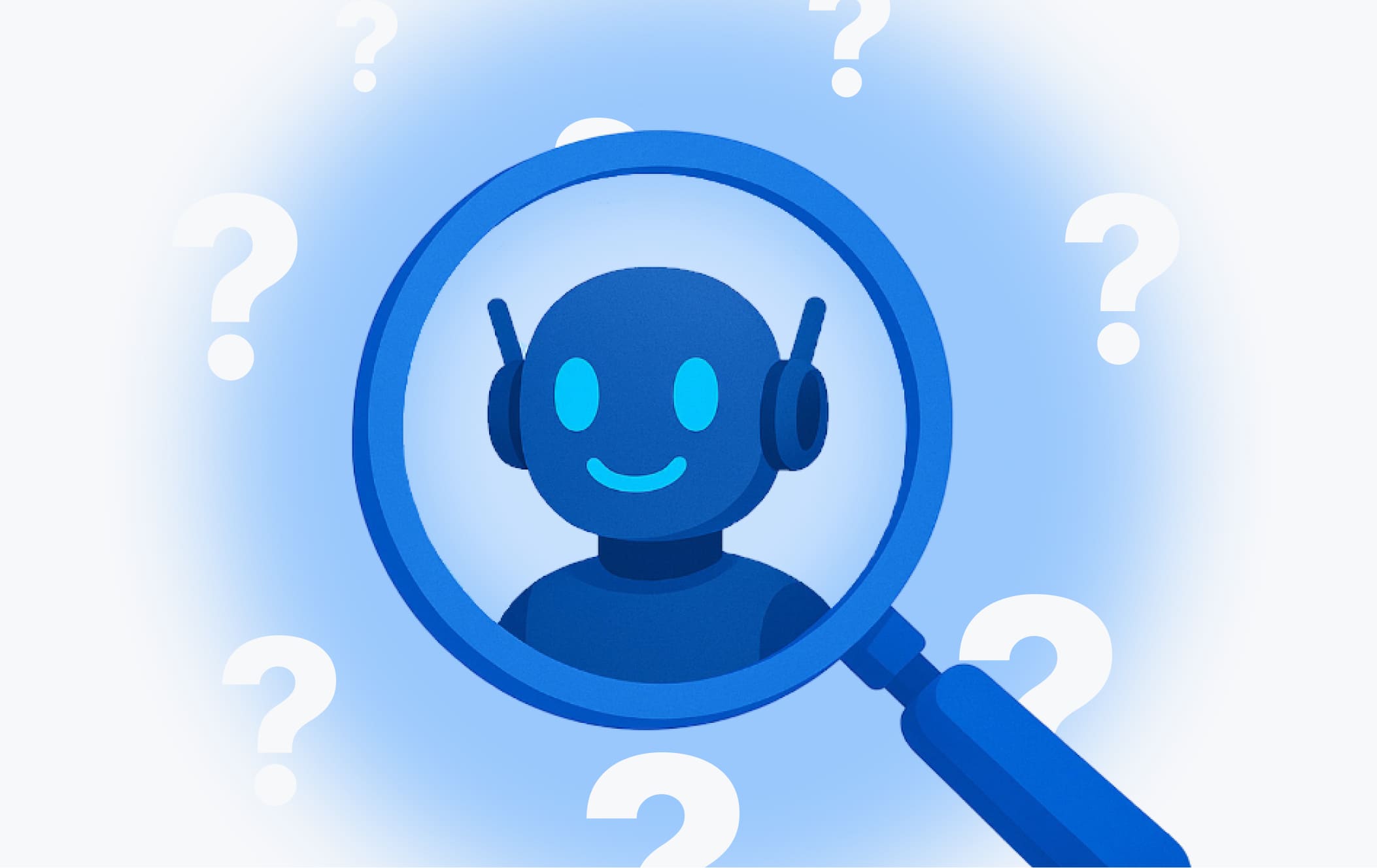Generative AI for Marketing: How to Automate 60% of Routine Work
Generative AI for marketing crunches numbers faster than any human, spots patterns, predicts performance, and launches high-precision campaigns that convert. It can reshape how your marketing works — and what results it delivers: lower cost per lead, higher conversion rates, and more return on every dollar you spend. In this article, we'll show how business owners like you can start integrating AI to free up time, reduce overhead, and amplify your ROI.
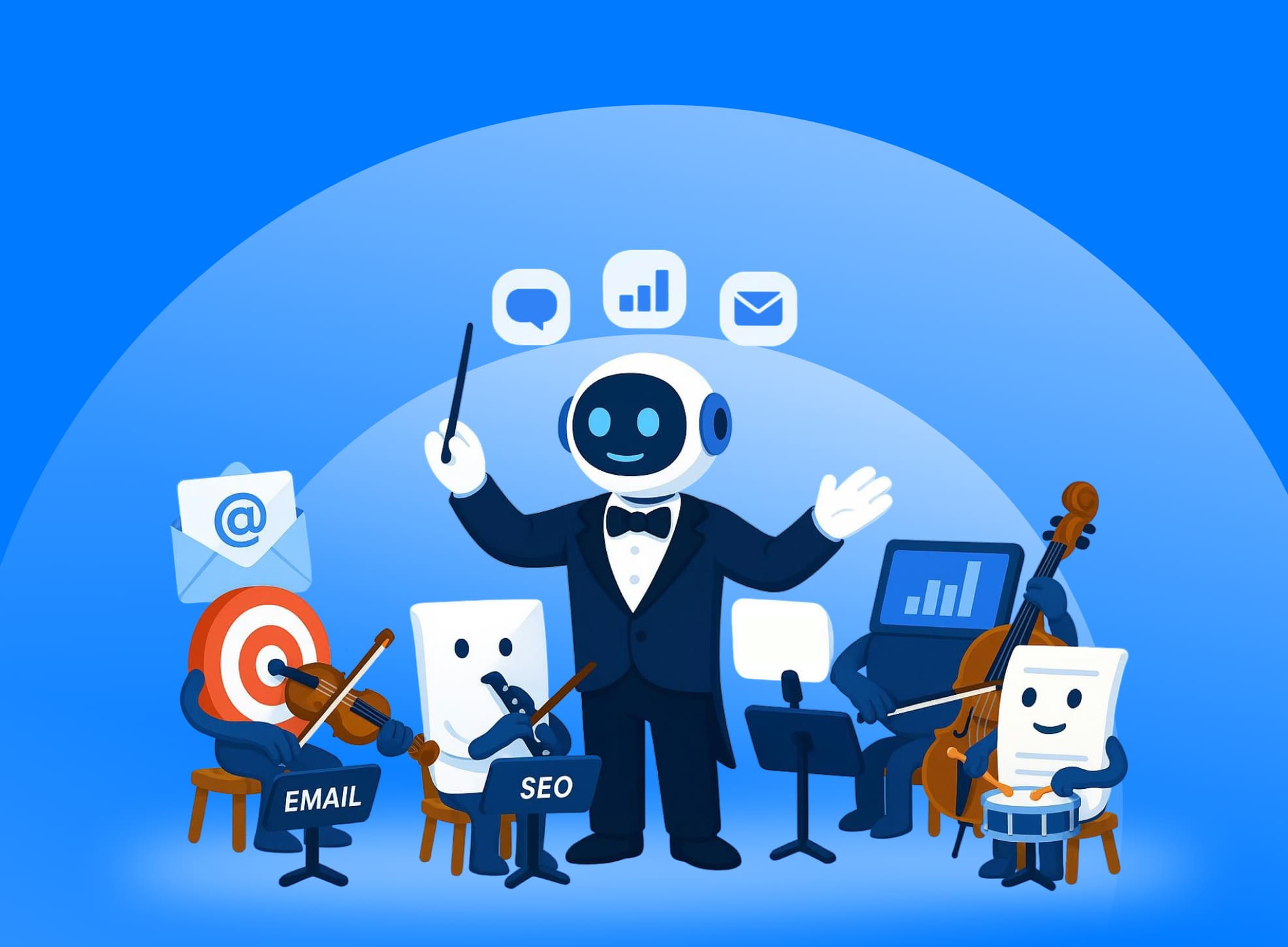
How did enterprise marketing teams operate before AI? Their marketing was manual by default. Launching campaigns, localizing content, updating messaging across markets — everything took weeks of coordination, rewriting, and approvals.
In an ideal world, you'd have a team of strategists, data analysts, content specialists, and project managers behind each initiative. In reality, your team is constantly switching contexts, chasing data, reworking copy, and trying to make fast decisions with incomplete information.
Generative AI for marketing changes that. Today, it can instantly analyze campaign performance across markets, localize messaging, generate on-brand content drafts in multiple languages, surface insights from customer data in seconds, and recommend optimizations before you even ask.
Instead of drowning in the details, your team gets to focus on what drives impact — while AI takes care of the repetitive, time-consuming tasks behind the scenes.
In this article, we break down how AI is actually being used in marketing today — with real examples, key metrics, and practical tips for those ready to stop watching from the sidelines and start using AI to drive serious results.
Generative AI for Marketing: Marketing Tasks AI Can Handle for Your Team Today
Generative AI for marketing can automate routine work, analyze data at scale, and support faster, more informed decisions. For marketers, that means better efficiency, sharper targeting, and stronger results. Here are just a few generative AI in marketing use cases and tasks AI can take off your plate, helping to achieve 3X productivity:
🔁 Manage Routine Tasks
While most teams already automate email scheduling or social posting, AI now supports far more complex, high-leverage tasks that previously required human input. What AI can actually automate:
— Weekly campaign planning and task coordination. AI can automatically build campaign timelines based on goal inputs, assign owners, track task dependencies, and re-prioritize based on shifting deadlines or resource constraints.
— Calendar balancing for multiple campaign timelines. If your team runs 5–10 campaigns across business units, AI can visualize resource conflicts, workload spikes, and deadline risks before they happen — and suggest adjustments.
— Generating performance summaries. Instead of manually assembling decks or updating dashboards, AI tools can write human-readable performance recaps, including comparisons vs. targets, traffic anomalies, and predictive insights.
— Meeting prep and post-meeting summaries. AI can scan upcoming agendas and generate background notes from relevant campaign data. Post-meeting, it can summarize discussion points, assign tasks, and send follow-ups.
🧠 Study Competitors and Understand the Audience
Rather than manually searching forums, surveys, and reviews, AI systems can parse and summarize large volumes of market data. This includes comparing competitors' pricing, service models, and messaging, spotting gaps in customer needs that aren't being addressed, and detecting patterns in customer sentiment across platforms.
What you can delegate to AI:
“Compare Brand A, B, and C by price, product features, user feedback, and differentiators.”
“Based on competitor analysis, suggest 3 unmet needs of customers in the wellness product market.”
“Summarize consumer behavior trends for Gen Z in online education.”
This helps teams make informed decisions, without reading 50 PDFs or crawling LinkedIn and review sites for days.
🔮 Tap into Predictive & Prescriptive Analytics
AI forecasts what comes next and suggests your best moves. That's the real power of predictive and prescriptive analytics in marketing.
— Predictive analytics uses machine learning to process large volumes of historical data — sales records, behavioral patterns, market trends — and uncovers what's likely to happen next.
— Prescriptive analytics takes it a step further: it uses those predictions to recommend concrete actions that lead to better outcomes.
What Marketers Can Do with It? In marketing, predictive models help answer questions like:
- Who's at risk of churning — and why?
- Which customers will most likely upgrade, and when?
- How much value will a lead generate over time (LTV)?
Prescriptive AI turns that knowledge into action, offering a timely discount, triggering a retention email, recommending a product upgrade, and prioritizing high-LTV leads. AI updates in real time as conditions change.
Imagine a large retail chain selling everything from electronics to groceries. Instead of guessing what might sell next month, AI can sift through sales data, seasonal trends, and customer behavior to offer insights like:
- “Smartphone demand is projected to spike in July — start stocking up now.”
- “Stationery inventory is overstocked. Reallocate resources to trending items.”
- “Supplier A has the highest on-time delivery rate. Consider prioritizing them for critical SKUs.”
Spotify's director of data science, Ruchika Singh, shared how the company uses predictive algorithms to shape each user's journey. From the very first interaction, AI models work behind the scenes to anticipate what content a user will want and when. The models are constantly refined to keep pace with evolving business goals — a key reason Spotify leads the streaming space, with over 226 million Premium subscribers.
At the core of Netflix's user experience is its AI-driven recommendation system. By analyzing viewing habits, search behavior, and time spent on genres, Netflix delivers personalized content suggestions that keep users engaged — and subscribed. With around 80% of streamed hours driven by its recommendation engine, AI plays a critical role in both user satisfaction and revenue growth.
🚀 Boost Your Sales with Smart Upselling & Cross-Selling
Ever booked a flight and been offered the option to pay extra for a better seat? Or upgraded your Netflix plan from monthly to yearly? That's upselling in action — encouraging customers to choose a premium version of what they planned to buy. Cross-selling, meanwhile, suggests complementary products that enhance the original purchase.
When done right, both techniques increase customer satisfaction and business performance. For instance, upselling alone accounts for an estimated 15–40% of McDonald's annual revenue.

Generative AI for marketing takes upselling and cross-selling to the next level:
— Personalized Recommendations. AI analyzes individual customer behavior and preferences to suggest the most relevant premium products or complementary items. If a company regularly purchases standard office printers, AI in B2B marketing might recommend premium models with higher capacity and advanced security features, or complementary products like bulk toner supplies and managed print services.
— Customer Segmentation. AI segments customers into groups based on purchase habits, demographics, and engagement, enabling targeted and effective upselling strategies. New customers might get introductory upgrade offers, while loyal customers receive premium bundles tailored to their past purchases.
— Automated Email & Messaging Campaigns. Gen AI for marketing crafts personalized upsell and cross-sell messages sent via email, SMS, or in-app notifications based on customer lifecycle stage and past purchases. After buying a smartphone, a customer receives an automated message offering discounted accessories like cases or wireless earbuds.
— Dynamic Pricing Strategies. AI helps set optimal pricing for upsell offers by analyzing market trends, competitor pricing, and customer willingness to pay. AI might offer a limited-time discount on a premium subscription to price-sensitive customers, while suggesting full-price offers to those who have shown higher spending habits.
Amazon's homepage is a standout example of AI-driven personalization. By analyzing browsing history, purchase behavior, and cart items, Amazon uses AI-based dynamic pricing to adjust prices in real-time, factoring in competitors, demand, and timing.
Whole Foods uses AI to analyze purchase history, browsing, and email engagement to segment audiences and personalize recommendations for cross-/upselling in their app.
✍️ Write Text for Any Task
With the proper solution and when prompts are crafted well, gen AI for marketing becomes a reliable assistant for everything, from short-form posts to complex technical narratives. In fact, Ahrefs analyzed 900,000 newly published web pages in April 2025 and found that 2.5% of pages contained fully AI-generated content, 25.8% were purely human-written, and 71.7% were a mix of AI and human content.
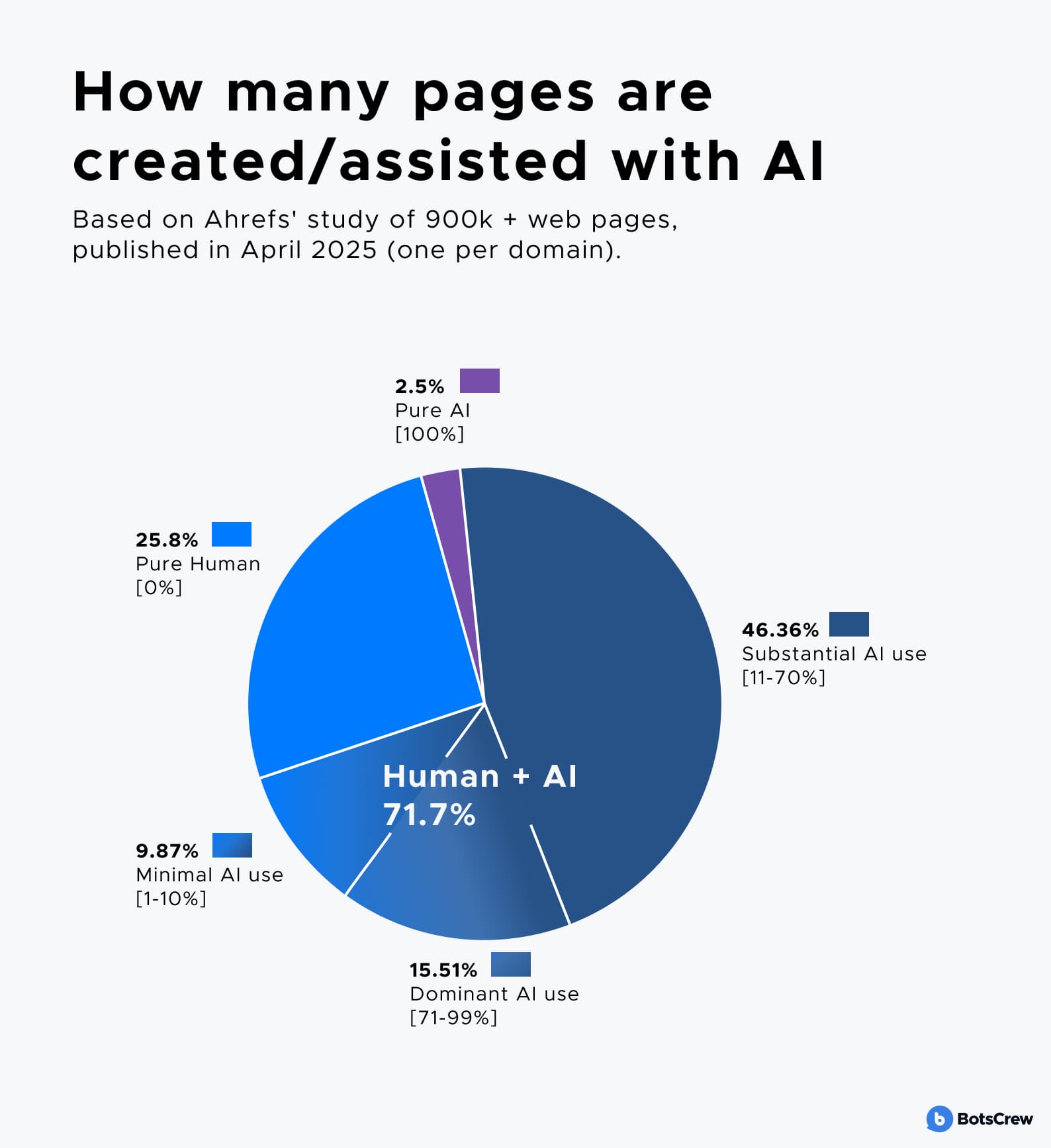
What AI can write:
— Blog posts for corporate websites. AI can generate first drafts for SEO-driven articles, thought leadership pieces, or technical explainers — based on structured briefs or outlines.
— Customer stories and case studies. AI can turn raw interviews or survey data into structured narratives — problem → solution → result — tailored for different industries or buyer personas.
— Email sequences and newsletters. Draft entire campaigns across the funnel, from welcome series to retention nudges, adapting tone and messaging based on user behavior or segment type.
— Social media posts. AI helps generate caption variations, split-test hooks, and tailor messages for each platform's format.
— Dynamic product descriptions. Gen AI for marketing rewrites technical specs into user-friendly formats and localizes content across multiple regions.
Moreover, different buyers want different things — specs for techies, design for homemakers, gift ideas for shoppers. Generic descriptions miss the mark and hurt conversions. AI analyzes user behavior to spot what they are really after. Later, it tailors product descriptions to each buyer type.
While AI can accelerate global marketing, true connection still depends on cultural relevance. That’s why many global brands rely on professional website content localization services to go beyond simple translation. These services adapt tone, visuals, and messaging to local cultures and preferences, helping marketers ensure every piece of content feels native and trustworthy. By pairing AI-driven speed with nuanced localization, businesses can scale globally without losing authenticity.
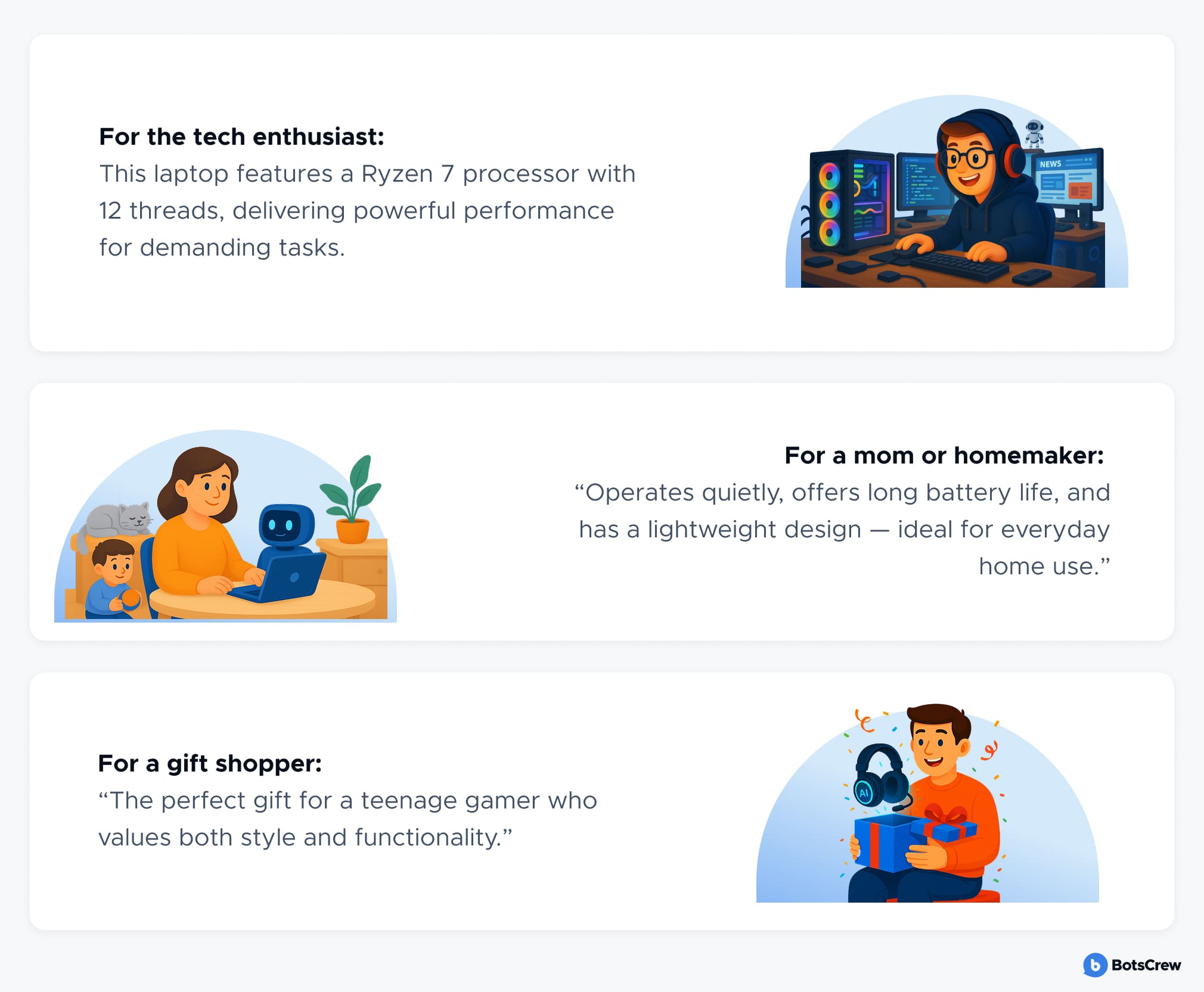
— Transforming existing content into new formats. Turn a podcast transcript into a blog summary, a blog post into a Twitter thread, or a webinar into bite-sized social media content — all in minutes. AI can also analyze past performance to identify which pieces are worth reusing, helping marketers get more value from existing materials.
— Content maintenance. Keep your content up to date with AI by spotting outdated info, broken links, and underperforming pages. Automated audits save hours of manual review, ensuring your content library stays fresh, relevant, and effective.
AI-driven content creation cuts production costs, allowing marketers to test ideas more quickly and respond to trends with greater agility.
Since 2016, The Washington Post has used the Heliograf bot to speed up news production. Initially built to cover the Olympics, it filled pre-made templates with real-time data and published results instantly. Over time, it expanded to cover routine news and even basic analysis — generating full articles in under 30 seconds using templates and keyword libraries prepared by journalists.
One of our clients in the Staffing & Recruiting sector was investing 8 to 16 hours and up to $600 into each blog post — a manual, time-consuming process that couldn't keep pace with rising content demands. Their small team needed a faster, smarter way to deliver high-quality, SEO-optimized articles without compromising standards.
We built an AI-powered content pipeline designed to support real writers, not replace them. The system mimics how experienced SEO writers work: selecting keywords, building structured outlines, sourcing relevant materials, and drafting full articles — all in one streamlined flow. It even pulls from internal content and executive-authored thought leadership to ensure brand consistency.
Within just two months of launch, the results were transformative. Writers produced 5 times more articles, content creation time dropped by 90%, and individual output surged from 8 to 92 articles per quarter.
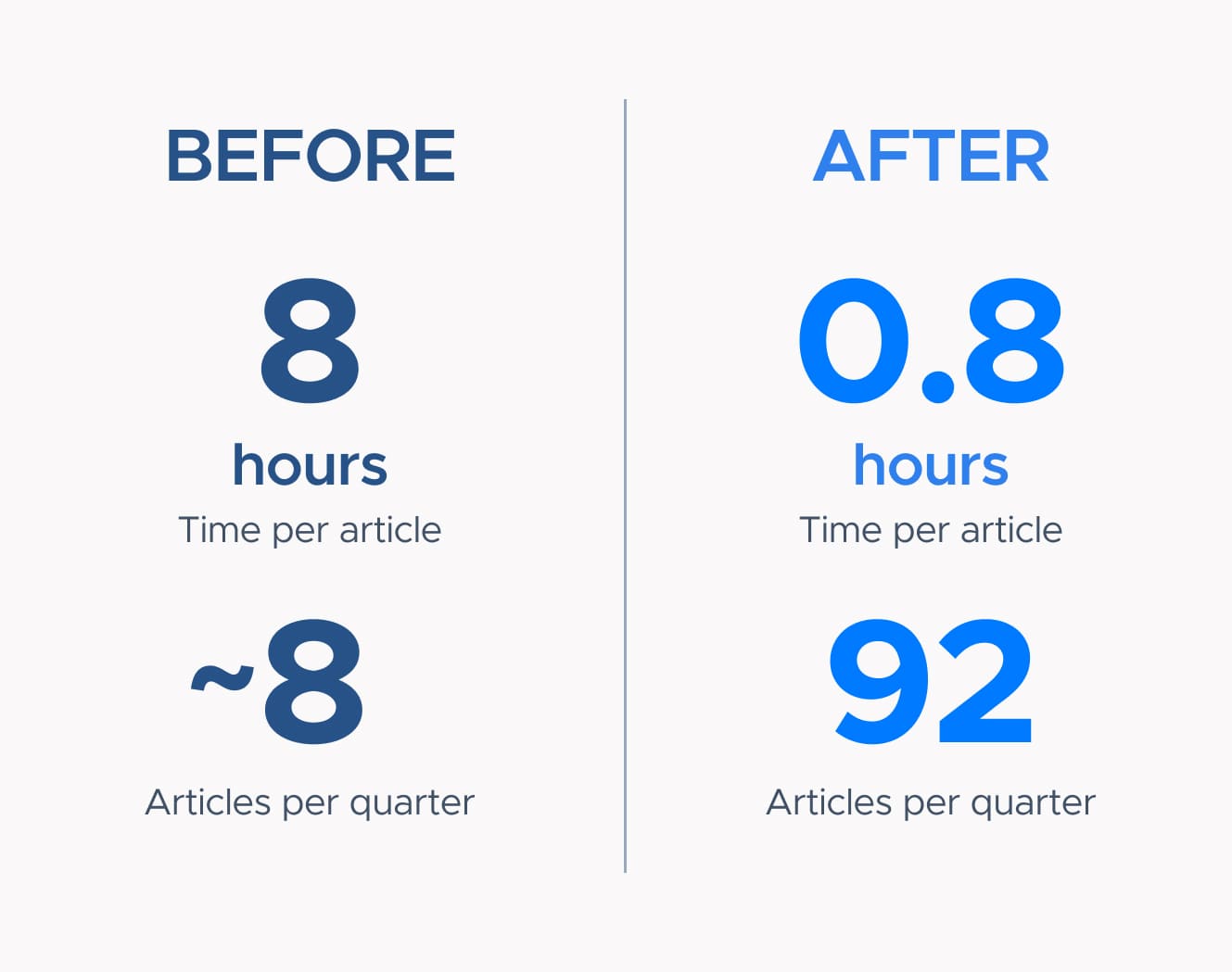
📅 Generate a Content Plan
AI can help create structured content calendars for different platforms, based on campaign goals, brand voice, and audience interests. You can generate plans for a month, quarter, or even the whole year. Where AI helps:
- Planning publications for social media, blogs, and newsletters
- Suggesting topics based on audience behavior and seasonal trends
- Balancing formats (articles, videos, infographics, stories)
- Aligning content with your marketing funnel.
Let's say a mid-sized tech company needs a 3-month plan for its LinkedIn page and industry blog. The AI suggests 12 blog post ideas (with estimated word counts), 20 social media posts (engagement + thought leadership), and a distribution schedule — based on the company's existing tone and known industry events.
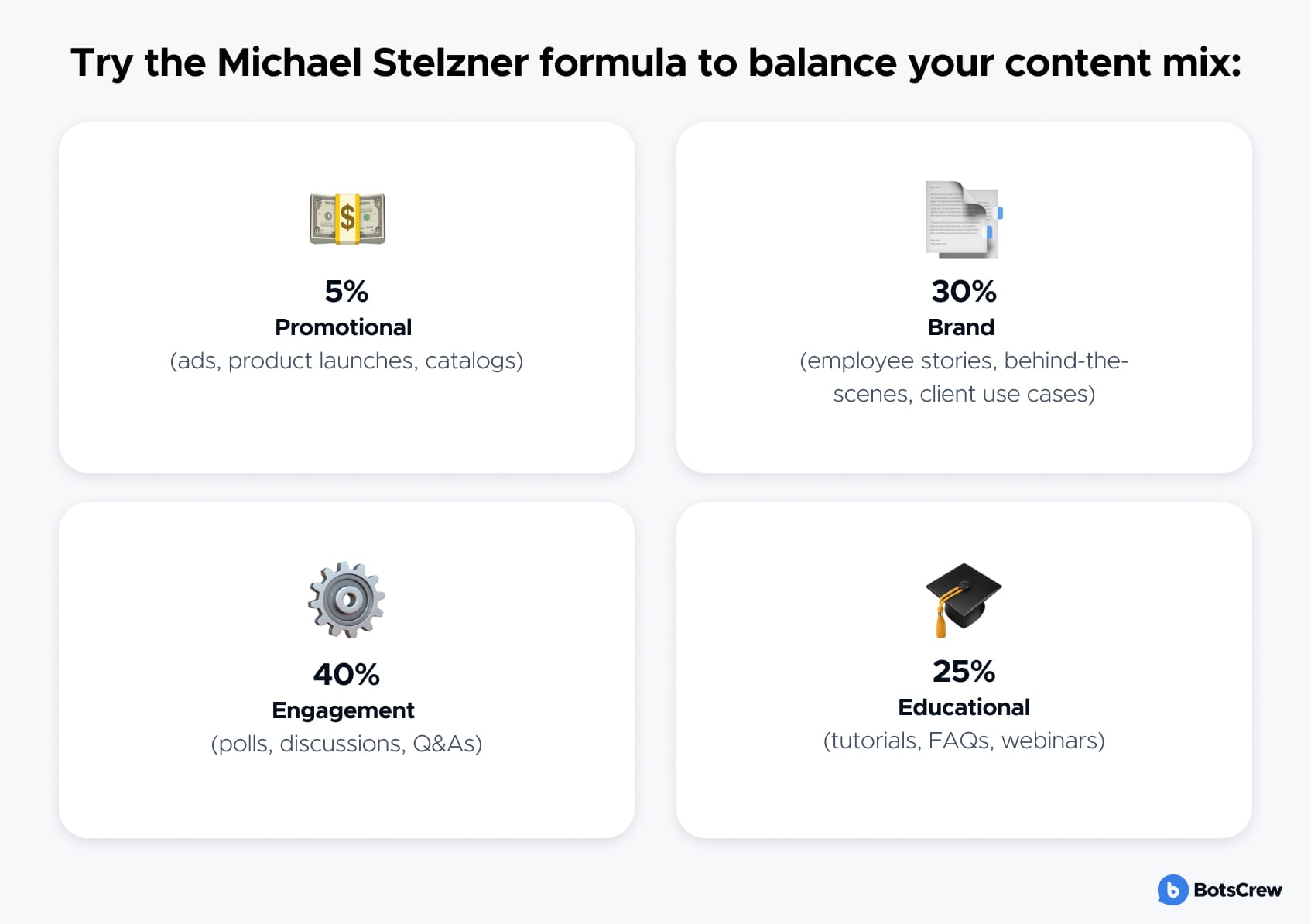
🛍️ Select Relevant Offers and Personalize Experiences
AI excels at turning generic customer journeys into highly personalized experiences. It tracks real-time behavior signals — like scroll depth, dwell time, cart abandonment, and search queries — to tailor product suggestions, content, or promotions for each visitor. What AI can help with:
— Personalized product and content recommendations. Suggest products based on browsing history, past purchases, or what similar users have viewed. The logic can be fine-tuned to prioritize profit margin, stock levels, or campaign goals.
— Hyper-personalized email campaigns. AI tailors subject lines, product rows, send times, and discounts in emails based on user-specific behavior — from price sensitivity to frequency of return visits. Before sending AI-generated campaigns, you need to maintain a healthy subscriber list. An email list verification tool helps you identify invalid, inactive, or misspelled email addresses, reducing bounce rates and protecting your sender reputation. Clean data ensures that your automated campaigns reach real, engaged users, maximizing the performance of your AI-driven marketing and keeping your communication credible and efficient.
— Live chat personalization. Combine AI chatbots with personalization engines. For example, when a returning customer visits during a promo, the chatbot starts the conversation with: “Hi [Name], still deciding on the [product]? We've got 10% off just for you.”
— Personalized remarketing ads. Feed AI-structured audience data into ad platforms (Meta, Google) to deliver hyper-relevant product carousels, especially for high-intent micro-segments like “users who added to cart 3 days ago but didn't purchase.”
Virgin Holidays, the UK's leading transatlantic tour operator, wanted to turn Blue Monday — the most depressing day of the year — into something fun. As part of their “Screw It, Let's Do It” campaign, they slashed prices on 200+ holiday activities to just $1 for one day only.
To spread the word and boost engagement, they teamed up with us to launch a Messenger chatbot with a twist — a friendly, emoji-filled travel buddy that talked like a true Californian. The goal? Recommend activities based on user preferences and help people quickly grab limited-time offers.
Together with Virgin Holidays and their PR team, we built the chatbot from the ground up. We designed the tone, flow, and personality, integrated with their activity database, and focused on simplicity and great UX. The chatbot helped to achieve massive user engagement and successful promo sales. Furthermore, Virgin Holidays even won an award for the campaign.
🤖 Use the Power of AI Chatbots & Virtual Assistants
AI-powered chatbots and virtual assistants are no longer just FAQ responders. They've evolved into intelligent, 24/7 front-line agents that support, convert, and delight users at scale. What AI chatbots can help with:
— Answering Common Questions. From order tracking and return policies to appointment scheduling or eligibility checks — AI handles it instantly.
— Qualifying Leads. Collecting user data, asking relevant questions, and routing qualified leads to sales — reducing drop-offs and speeding up response time.
— Form-Fill & Navigation Assistance. Guiding users through applications, insurance claims, or checkout processes — especially in industries with multi-step forms such as Healthcare & Insurance, Banking & Financial Services, or Travel & Hospitality.
— Multilingual & Global Support. Supporting international audiences with real-time translation and localization.
— Sentiment Detection. Spotting frustrated or confused users and escalating to a human when needed — improving experience and retention.
Airbnb uses AI-powered chatbots across its platform to streamline both the guest and host experience:
✅ During search: The chatbot helps users find stays by asking about budget, dates, group size, or desired amenities — acting like a virtual concierge.
✅ During booking: It assists with payment questions, refund policies, or last-minute changes, reducing friction.
✅ Host support: Airbnb also uses bots to help hosts troubleshoot issues, update listings, and manage cancellations faster.
We collaborated with Adidas and Hill+Knowlton Strategies to launch the “Pitch, please” WhatsApp chatbot, designed to help women, girls, and non-binary players easily book football pitches in London. With just 1.5 weeks before launch, H+K turned to BotsCrew to deliver the solution fast and effectively.
We mapped out the conversation, built the brains behind the bot, ran it through internal testing, got the green light from the client and launched it right on time for the campaign kickoff. The bot guided users through a few quick questions, allowing them to book available pitch time slots, get directions via Google Maps, share the chatbot on social media, and leave feedback on their experience.
The campaign ran for one month and exceeded all expectations. A total of 338 users engaged with the chatbot, and 149 of them booked a pitch, surpassing the original goal of 100 bookings. In the end, 345 people showed up to play at Haggerston School and Fulham FC's Motspur Park.
Even after the campaign ended, users continued messaging the chatbot in hopes of booking a pitch. We updated the welcome message to guide them to a new website where future bookings could be made.
Let your data work smarter — and show real impact within weeks. Book a quick 30-min demo to explore how.
Assess Your Company's AI Maturity
AI is changing the game in marketing — but how prepared is your business to make the most of it? Understanding your AI maturity helps identify strengths, gaps, and opportunities for smarter, faster marketing.
Key Questions to Benchmark Your AI Readiness:
#1. How is AI currently used across your marketing functions?
Take a look at how different teams — content, campaigns, events, performance — are (or aren't) using AI. Is there a structured process in place, or is usage ad hoc? Are there guidelines for responsible and effective use? Knowing this helps you move from experimentation to strategy.
#2. What shape is your data infrastructure in?
AI is only as good as the data it's fed. To produce personalized, brand-aligned outputs, you need clean, accessible, and well-managed data. Ask yourself:
— Is your data organized and governed properly?
— Can teams easily access the right datasets?
— Are you leveraging data for segmentation, insights, and decision-making?
#3. How confident and skilled is your team with AI?
If team members are already experimenting with AI, great! But how advanced are their skills? Look at the types of prompts they use. Are they simple or strategic? Survey your team to understand their comfort level, willingness to learn, and where skill-building efforts are needed.
#4. What tools are in play and how are they used?
Take stock of the AI tools your team is using. Are they relying on free versions with personal logins, or is there centralized access to premium features? Also, explore whether you're fully utilizing AI features already embedded in your martech stack.
Evaluate:
- What tools are being used (chatbots, image generators, embedded AI)?
- What are they used for?
- How well do they integrate with your current tools?
- Where are the gaps and opportunities?
By asking these questions, you'll get a clear picture of your AI maturity — from isolated experimentation to integrated, strategic use. If you found that AI usage is inconsistent, data is siloed, or skills are limited, you are likely still in the early stages. And that's okay, most organizations are.
The good news? You don't need to overhaul everything at once. Start by identifying one or two areas where AI can make a measurable impact — like content generation, customer insights, or campaign optimization. Build from there.
And if you're looking for a reliable partner to help accelerate your journey, we are here to help. As an experienced AI solution developer, we work with businesses to design and implement tailored, scalable AI systems that drive real results.
👉 Let's talk about how we can move your AI strategy forward.
The Human Factor: Still Essential in an AI-assisted Environment
According to The 2025 Sprout Social Index™, 32% of social media marketers worry AI might make their roles redundant.
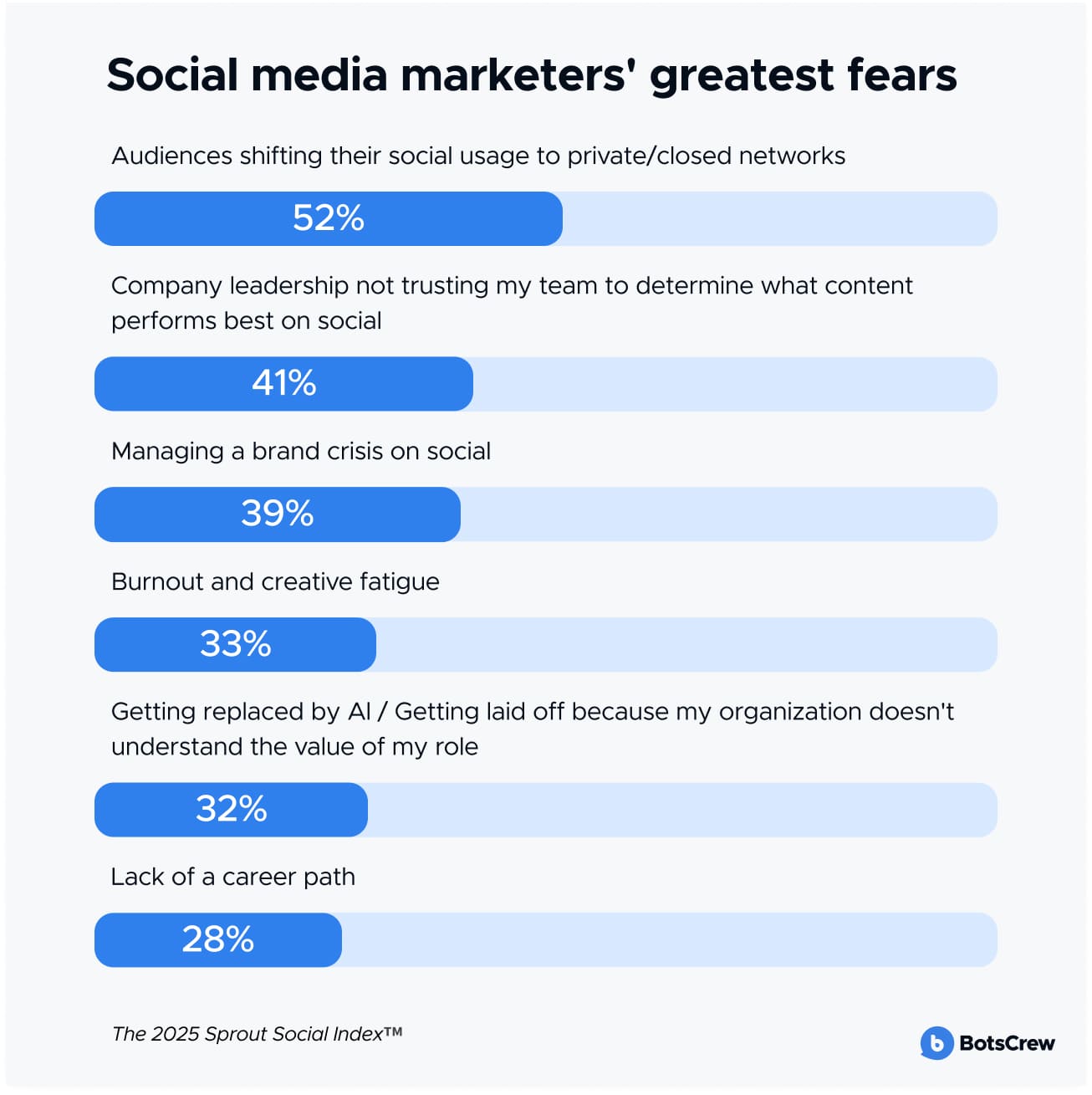
We ran a focused experiment to see how AI could strategically support our workflow. Until then, we'd hardly used AI in content creation. Instead of handing full control to ChatGPT, we tested where it actually adds value (and where it doesn't). What worked well:
✅ Researching topics and sourcing studies
✅ Drafting briefs and outlines
✅ Proofreading and QA
✅ Generating FAQs and meta descriptions
✅ Speeding up visual creation with design tools.
What didn't work? Letting AI write full articles. The output was too generic, off-brand, and lacked the depth we aim for.
AI won't replace marketers. But it will replace those who don't use it. AI can't replace your brand voice, values, or intuition — but it can give you more time, better ideas, and the ability to scale faster.
Imagine using a fully AI-integrated marketing platform. You insert a prompt about your product, customer journey, and ideal client. You connect it to your CRM, website, and content sources — and the system gets to work. It generates personalized campaign flows, tailored emails, dynamic web experiences, and smart sales talk tracks.
Next, the platform runs predictive analysis to identify which customer segments are most likely to convert this week. It automatically schedules posts for the best-performing times, writes variations of copy to A/B test, and suggests high-impact visuals based on current trends and brand tone.
Your marketing and sales teams receive AI-generated follow-up prompts with suggested messaging based on recent client interactions.
Meanwhile, the platform monitors engagement in real time, refining campaign elements on the fly, adjusting subject lines, retargeting rules, and even CTA wording to optimize performance continuously. By the end of the week, you've launched a multi-channel campaign, reached thousands of potential leads with laser precision, and freed up hours to focus on creative strategy and brand innovation.
No manual tweaking. No guesswork. Just smart execution at scale — with you firmly in control.
Ready to future-proof your marketing strategy? Let AI handle the heavy lifting while you focus on what matters most — creativity, strategy, and growth. Contact us today to see how AI can supercharge your marketing workflow.




